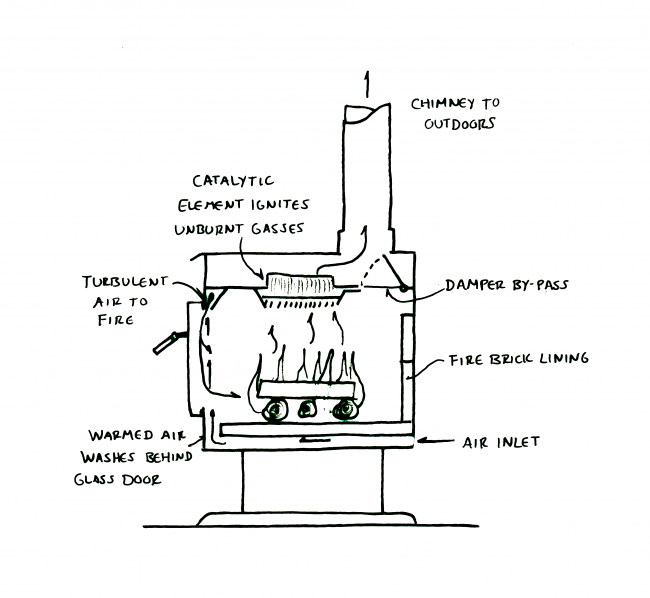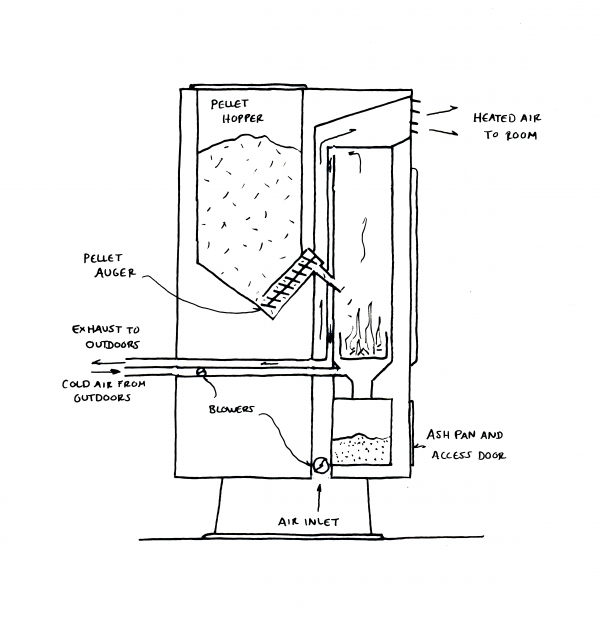Wood & Pellet Stoves
HVAC: MATERIALS ENCYCLOPEDIA
Heat production & delivery
Biomass heat production (wood- and pellet-fired)
Passive air/radiant delivery system
Hydronic heat delivery available for some systems
Forced-air delivery available for some systems
Can be used for domestic hot water heating
System components
Burn chamber and ash pan
Air inlet and controls
Exhaust outlet and controls
Fuel delivery system (pellet stoves)
Blower fan (some units)
Water-heating coil or tank (some units)
How the system works

 A freestanding unit is placed, usually centrally, in the home. The unit has a burn chamber where a fire is lit and burns, heating a combination of masonry and metal around the chamber.
A freestanding unit is placed, usually centrally, in the home. The unit has a burn chamber where a fire is lit and burns, heating a combination of masonry and metal around the chamber.
Combustion air is introduced through a manually or mechanically controlled inlet. Ideally, this air enters through a sealed inlet directly from outdoors. This is nearly always the case with pellet-burning units, but not as common with woodstoves.
Exhaust is vented through a chimney. This is accomplished passively in some units (mostly woodstoves), relying on the warm temperature of spent exhaust gas to provide an upward draft. In some units (mostly pellet stoves), a fan is used to draw combustion gasses out of the burn chamber and through the chimney.
The heat from the fire makes the metal surface of the unit hot, and the heat is transferred radiantly and also through significant convection loops formed as air is heated by the stove and rises with some force. As warmed air moves along the ceiling it cools and falls. Room shape and the location of door and window openings will help determine the paths of convection loops.
A fan may be incorporated to actively move heat from the stove into the room. Minimal ductwork is incorporated in some units.
Rare models feature the ability to heat water within the stove. This can be a contribution to hydronic space heating and/or domestic hot water.
Fuel for woodstoves is manually input directly into the firebox through an opening door. Pellet stoves use an auger to automatically deliver fuel for combustion from a supply hopper. This hopper must be filled with pellets as required. Large hoppers can be used to ensure long periods of unattended operation.
System output
Rated outputs for woodstoves are estimations, and actual output will be dependent upon combustion air supply, chimney draft and the species and dryness of firewood. Typical residential models range from 50,000–200,000 Btu/hr. Burn efficiency is also difficult to accurately establish, but manufacturer claims range from 65–80 percent.
Pellet stoves have more accurate ratings, as pellets have relatively uniform density and moisture properties. Typical residential models range from 30,000–160,000 Btu/hr. Manufacturers claim burn efficiencies ranging from 70–90 percent.
Environmental impacts:
Material costs: low to Moderate
Labor input: low to moderate
Chimney installation is the largest labor component with solid fuel devices. Woodstoves require an extensive chimney that must exit the building through the roof, adding complexity and cost. Pellet devices are typically direct-vented, using fan-driven air and chimneys that can exit the building directly through the wall, a simpler solution requiring lower labor input.
Skill level required for the homeowner
Installation — Moderate to Difficult. In many jurisdictions, a licensed professional must install stoves. Owner installation requires making penetrations through wall and/or ceiling/roof for the chimney and inlet air.
Use — Moderate to Difficult. Stoves must be monitored regularly for temperature regulation, and fuel added as required. Pellet stoves typically have automatic ignition, removing the need to light fires when needed.
Maintenance — Moderate to Difficult. Ash pans must be emptied regularly, and combustion chambers cleaned. Chimney inspections should be performed at least twice a year.
Sourcing/availability: Easy to moderate
Competitive quotes for supplying and installing wood and pellet stoves are available in all regions with a heating season.
Code compliance
Woodstoves are an acceptable solution in all codes, but many codes will not accept them as a “primary” heat source, requiring some form of automated heating system to ensure the home can be heated if the stove is not running. This does not mean that the homeowner cannot use the woodstove as the main source of heat, but another form of heat must be included.
Pellet stoves are a more recent addition, and are an accepted solution in most codes. They currently occupy a “grey area” in regards to their use as a primary heat source, as they can be fed automatically for a length of time that corresponds to the storage capacity of the hopper.
Durability: moderate to high
Woodstoves are very durable. Most have no or only simple moving parts and can be expected to last for the lifetime of the building.
Pellet stoves have more mechanical components, but have shown themselves to be quite durable. Expected lifespan is fifteen to forty years, with manufacturers offering warranties from five to ten years.
Indoor air quality
Wood and pellet burning devices will have a negative impact on IAQ.
Woodstoves — The movement of cordwood through the home and its storage in the home can introduce large quantities of mold spores, dust and other outdoor allergens. The collection and movement of ash will result in some amount of the material being spread in the air. As the woodstove is opened to feed the fire, combustion gasses and ash will enter the room, and this process is repeated many times a day.
Pellet stoves — Filling the hopper with pellets and emptying the ashes will introduce significant quantities of dust into the air. Hoppers can be placed outside the building to significantly eliminate this source of dust.
The high surface temperature of the stoves can cause large convection currents that circulate dust and allergens. Dust can also be burnt as it touches the stove body, resulting in combustion by-products from a wide variety of particles.
The use of wood- or pellet-burning devices should be accompanied by the use of a good quality active air filtration system if indoor air quality is a priority.
Adequate ventilation is required in any well-sealed home. Whether provided actively or passively, ensure that pre-warmed fresh air is introduced and circulated in the home during seasons when windows are closed.
Future development
Woodstoves — Developments in wood-burning technology in the past couple of decades have seen the widespread adoption of secondary combustion systems that help to burn unspent gasses before they exit the unit. Without a move toward more active systems, including gasification and other fan-driven technologies, woodstoves are unlikely to see substantial change.
Pellet stoves — Residential pellet stoves are relative newcomers, and large improvements have been made over the past couple of product generations. Efficiency rates have risen and reliability and controls are better and more accurate. There are likely to be several more generations of improvement before the technology becomes more widespread and stable.
Resilience
Wood and pellet stoves are ideal heating systems for low- or no-energy scenarios, where fuel stocks are readily accessible.
Tips for a wood or pellet stove
1. The positioning of the unit in the home will affect performance, especially where heat transfer is entirely passive. Central positioning is usually considered ideal, but placement should correspond to areas where more or less heat is desired in the home.
2. Chimney installation often has to be done by a licensed professional. Chimney position should ensure proper clearances, lengths, minimal bends and proper height.
3. The need to bring fuel to the stove and remove ash should be considered when deciding upon placement.
4. Every stove will have specifications for minimum clearances from all sides of the unit, and for chimney placement and floor protection. Be sure to follow these guidelines accurately.



